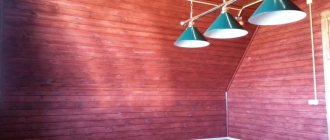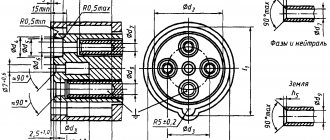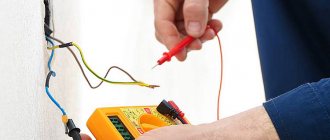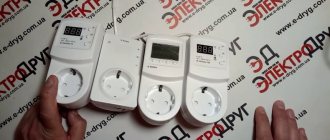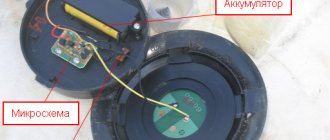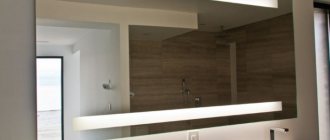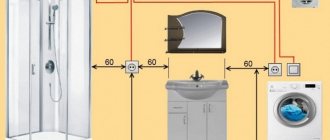Content:
- Why do you need sockets in the bathroom?
- Is it dangerous to install sockets in the bathroom?
- Where is the best place to place the outlet?
- Optimal height for socket
- What sockets can be installed in the bathroom
- Pull-out blocks and hatches
In Soviet-built houses, sockets were usually placed outside the bathroom to avoid accidents. From a safety point of view, this is justified, but it is extremely inconvenient when operating household appliances. The development of more advanced installation schemes for electrical systems in homes and the emergence of specialized electrical installation devices have simplified the task. Now it is absolutely no problem to place several power points for various home appliances in rooms with high humidity.
Installation
Installation of sockets in the bathroom from scratch should be done based on the recommendations:
- Before installation, the line is equipped with a separate automatic switch for emergency shutdown;
- each socket has a separate connection with a separate wire;
- the socket is equipped with a grounding cable and a cover;
- the device should be located no closer than 60 cm from water sources;
- installation is carried out without repair, so the socket must be equipped with a separate cable, which is connected to the distribution panel via an automatic machine.
The following tools will be required for installation:
- indicator for measuring voltage;
- Phillips screwdriver;
- knife or special tool for removing insulation;
- level;
- drill;
- pliers.
Then the installation process begins. Conventionally, it is divided into 4 main stages:
- Drilling holes into which dowels are installed. They are needed to secure the device.
- Then prepare the wiring. The tips are cleaned from the insulating layer using a knife or a special cleaning tool.
- Afterwards, the bolts are installed in the prepared holes. Then they connect it to the socket and attach it in a box to the wall with dowels. Moisture-resistant devices are equipped with ready-made holes, which are equipped with rubber plugs. They are where the wiring is connected before connecting to the electrical network.
- The final step is to install the housing in the designated place and supply electricity.
If a built-in socket is installed, then at the first stage you need to make a hole in the wall along the diameter of the box.
After which it needs to be installed on a plasterboard wall using special screws and the wires connected. Installation of an additional outlet is carried out according to a similar algorithm, but with a slight difference. There are 2 ways to connect the cable:
- laying a new electrical cable line from the panel, installing a separate circuit breaker;
- installation of a transformer, in this case grounding is carried out from the nearest electrical point.
The remaining steps are the same as for the initial installation. When installing additional equipment, it is necessary to make additional holes in the facing coating; for this purpose, specially designed drills and crowns are used.
When installing, follow safety precautions:
- installation is carried out in a de-energized apartment;
- check the wires with an indicator before connecting;
- Avoid contact with exposed wires.
If you follow simple installation rules, you can connect the outlet in the bathroom yourself without much effort.
Sockets can and should be installed in bathrooms.
To comply with safety requirements, electrical sockets are installed only in the third zone of the room at a certain height and distance from water sources, with a degree of protection IPx4 and higher, they must be equipped with grounding, an automatic circuit breaker or RCD installed to turn off the power in case of current leakage
The choice of outlet is made taking into account the devices connected to it and their total power. For small household appliances: curling iron, razor, you can use 8 A sockets. For powerful devices, such as a washing machine and water heaters, you will need 16 A sockets. By observing the above installation and installation requirements, any person without special knowledge and skills can independently connect the device.
Why do you need sockets in the bathroom?
Bathrooms have traditionally become home to washing machines, as well as the main location of water heaters, electric shavers and hair dryers. Today, the range of devices used has expanded significantly. Forced ventilation systems, dryers, electric dryers, hydromassages, heated floors, additional lighting, chargers for mobile devices, electric toothbrushes, etc. Based on the needs of users and the number of appliances used, it is advisable to install 2-3 sockets in the bathroom.
Safety standards
The use of automatic devices (RCD) will help avoid life-threatening situations. The residual current device stops supplying current if a breakdown occurs:
- There is a visible leak on the socket body.
- A short circuit has occurred.
- The current-carrying parts of the device are accessible and there is a possibility of a person touching them.
The machine is selected based on the main indicator - the digital designation of the leakage current.
The indicator is imprinted on the body of the machine (in µA). The machine operates at a maximum value of 30 µA.
- Schematic representation of the washing machine power supply from the mains
- As an additional guarantee of the safe operation of the electric point, a 10 µA automatic machine is installed in the bathroom.
- Such sensitive machines are installed on new lines so that they do not stop work on the old line due to false reactions.
- The power point with the household unit in the bathroom is connected to the machine. It is led outside the room to the main panel of the house.
- Without a grounding cable, there is no complete safety chain. It equalizes potentials to a completely safe level.
It is prohibited to use old methods of grounding through a metal pipeline or building fittings.
Is it dangerous to install sockets in the bathroom?
Placing any electrical appliance in a room with high humidity and frequent splashes of water poses a potential hazard. Water is an excellent conductor, which increases the risk of electric shock if it leaks. Even a small fault can lead to a short circuit. However, if you follow safety precautions, install power points in accordance with current standards (GOST R 50571.11-96) and use sockets with water protection, the danger is reduced to zero. Modern rules for the design of electrical installations (PUE 7.1) regulate in detail all the nuances.
Surface-mounted waterproof socket
The technology most often used, due to its simplicity, involves external installation. There is no need to use any additional devices. The socket block is disassembled and the position of the mounting holes is marked on the wall surface. The verticality of the marking must be controlled using a building level.
Holes in the wall are made using a drill. To do this, use a diamond-coated crown or a drill for tiles, and when covering with plastic panels, use wood or metal. For the main material of partitions (brick or concrete), a hammer drill is best suited.
Overhead waterproof socket.
The body is attached to the wall surface using dowel nails. To prevent condensation from seeping through, the fasteners are treated with a small amount of sealant. Then a contact block with the mounting end connected to it is installed in the mounting protrusions. Next, all that remains is to put the housing cover back and secure it with screws.
Where is the best place to place the outlet?
The bathroom can be divided into several electrical safety zones. They are usually designated by numbers from 0 to 4.
- The zero zone
is the bathtub, shower stall or tray itself, their internal space, as well as the vertical plane near which they are located. In this area, devices with a high degree of protection IP67 or IP68 can be used. The supply voltage should not exceed 12 V - Zone 1
includes the adjacent space up to 2.25 m high. Typically, boilers, water heaters and sockets with a protection index of IP55 are installed in this area. It is not forbidden to use the space under the bathroom, provided that there is open access to it. - Zone 2
starts from a distance of 60 cm from the first zone, as well as the upper tier of the room above 2.25 m. This is the legal place for lighting systems, ventilation, hydraulic drives, as well as sockets with water protection no less than IP44. - Zone 3
is the volume that is located 240 cm horizontally from zone 2, and everything above it. Splashes of water rarely reach here, the movement of air currents increases, therefore it is allowed to use equipment and electrical installation products of IPX1 class.
In short and in simple language, the further the outlet is from the source of water or heat, the better. It is not recommended to install power points behind the equipment; it is more convenient to install them on the left, right or bottom. The outlet should always be freely accessible so that you can replace it or quickly turn off the device.
Types of electrical outlets
A socket is a plug connector designed for connecting household appliances and instruments and industrial machines.
To select electrical outlets for premises, it is not enough to choose the model you like. You need to have an initial understanding of the different types of devices and take into account a number of factors in the process of selecting models for different rooms.
There are several types of socket devices, grouped into blocks:
- By installation type. Based on this feature, sockets are usually divided into hidden and overhead. The first ones are placed in rooms where decorativeness is important and there is no room on the walls for protruding elements. The latter are used in wooden houses and cottages where retro wiring is planned.
- By number of connectors. Sockets with 1 to 3 connectors are widely used. Devices with 4 or more connectors are installed and used in places that require connecting a large number of electrical appliances.
- By connector type. This refers to marking using Latin letters. In Russia and post-Soviet territories it is customary to use the letters C, F and E. There are at least 13 of them all over the world.
There is also a division based on voltage - 220 V (for household appliances) and 380 V (for machine tools and complex machines).
When choosing sockets, manufacturers recommend paying attention to the manufacturer and the color palette. You should not give preference to inexpensive products made from cheap materials: devices significantly lose in such indicators as reliability and safety.
Optimal height for socket
Typically, electrical sockets are installed at a height of 90-100 cm from the floor. The user does not have to bend over or reach up to connect/unplug the plug. In residential premises, it is allowed to place power points at a distance of 30 cm from the floor. But it is not recommended to do this in the bathroom. Firstly, flooding cannot be ruled out, and secondly, condensation may accumulate in the lower tier. Therefore, the optimal distance for installing a socket will be about 90 cm from the floor line, 10 cm from a window or doorway, 15 cm from the ceiling.
Wiring
The first thing you need to pay attention to is the electrical wiring. In the bathroom it should be hidden.
This means that it should be laid inside walls or slabs. Such wiring will ensure that there is no risk of fire or short circuit.
What sockets can be installed in the bathroom
Electrical installation devices installed in rooms with high humidity are subject to higher requirements. The presence of grounding, protective curtains for plug holes and a tight hinged lid is considered mandatory. In addition, they must withstand increased load. Legrand sockets from the Plexo series with water protection IP 55 meet all these conditions. The rubberized housing prevents water from getting inside. There are blocks of two or three sockets of the same series, which is very convenient. Legrand can also offer installation boxes (Botibox series) for quick and easy installation/replacement of the power point.
Outdoor sockets
If you plan to install waterproof devices in outdoor conditions for a country house, cottage or summer house, you should pay attention to certain points.
Do not use extension cords that are extremely long (100 m). You just need to consider the location of the outlets on the outside of the house. For this purpose, you can use the supports of wooden gazebos, the internal parts of fence supports, the outer walls of the garage and other utility rooms.
It will be possible to successfully connect devices for various purposes into ready-made socket connectors. This could be an electric saw, a stove or barbecue, an external audio system or a television panel.
Pull-out blocks and hatches
An interesting modern solution for the bathroom would be to use a pull-out block or hatch for installing several sockets. The main advantage of such devices is the hidden nature of their placement, a high level of security and aesthetics. The blocks have a vertical orientation, have a lifting mechanism and an opening button on the front panel. They close by pressing until there is a characteristic click. Such a unit can be installed, for example, in a countertop next to a sink or washing machine.
A type of built-in unit is “hatches” with a lifting lid. You can install regular, power or media sockets in the hatches (which is especially convenient if you plan to place a TV or audio system in the bathroom). There are options with one, two and three sockets. Such units have a degree of protection IP44. This means that the housing is protected from splashes and the ingress of solid particles with a diameter of more than 1 mm.
Experts recommend not saving on electrical installation products, since a person’s life and the safety of his property depend on them. In addition to sockets, Legrand can offer users switches for lighting, heating, forced ventilation systems, and thermostats for underfloor heating from the waterproof Plexo series. These devices are designed for use in conditions with high humidity, have a high level of electrical safety and an elegant design.
Selection of sockets by marking and device
It is visually difficult for an inexperienced person to understand which socket is suitable for the bath and which for the kitchen. At first glance they are the same. If for a kitchen the level of protection from dust is important, then for a bathroom the level of its moisture resistance is necessary.
Experts advise choosing a socket with a marking of at least 4.
- The IP55 or IP65 markings are most often chosen.
- The second number is the level of moisture protection.
- The device with marking numbers 6,7,8 is not afraid of being hit by a large jet of water.
A model with a spring lid will further strengthen the confidence that all safety measures have been taken. Thanks to this spring, the lid will not open accidentally.
In a bathroom where there is a high level of moisture, you cannot install the socket block in an open way. They are installed inside a casing with increased tightness.
The photo shows a model of a bathtub socket with protection, which, when selected, can reduce the waterproof IP rating.
Devices from the following brands have been tested:
- France, Schneider Electric;
- Germany, GIRA;
- Switzerland, ABB;
- Assembly in Russia, Wessen;
- Italy, Bticino;
- Türkiye, Viko.
Selection of cable cross-section for its installation
Regulatory documentation requires that the cable be laid in a closed way in the bathroom. Under the cable, grooves-channels are made in the walls. When the wiring is laid in the channels, plaster and facing material are applied on top.
Running a cable over the wall is an open installation. This option will require less effort and time. In this case, the cable must be protected with corrugation or a cable channel.
Whatever laying method is chosen, passage in the “0” zone is not permissible.
The data sheet for each household appliance indicates its power. Depending on this, the cable cross-section is selected. It is calculated how many equipment are powered at the same time. The cable cross-section is selected based on the expected load on it (table).
For example, to power a washing machine, a copper cable with a cross-section of at least 2.5 mm is selected. If this wire will power a couple more household appliances (boiler, underfloor heating system), then without a cross-section doubled, the wiring will not be able to cope with the load. Otherwise, the cable will heat up and the insulation will melt.
